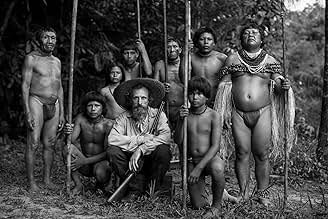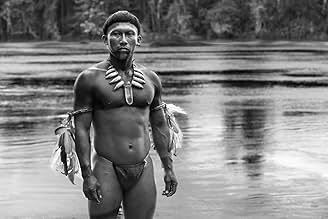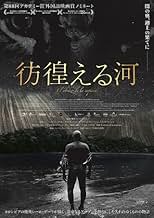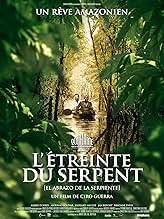IMDb रेटिंग
7.8/10
25 हज़ार
आपकी रेटिंग
करमाकेत, जो की एक अमेजोनियन शमां और उसके लोगों के अंतिम उत्तरजीवी है, और दो वैज्ञानिक जो चालीस वर्षों से एक साथ मिलकर पवित्र उपचार संयंत्र के लिए अमेज़ॅन की खोज करते हैं.करमाकेत, जो की एक अमेजोनियन शमां और उसके लोगों के अंतिम उत्तरजीवी है, और दो वैज्ञानिक जो चालीस वर्षों से एक साथ मिलकर पवित्र उपचार संयंत्र के लिए अमेज़ॅन की खोज करते हैं.करमाकेत, जो की एक अमेजोनियन शमां और उसके लोगों के अंतिम उत्तरजीवी है, और दो वैज्ञानिक जो चालीस वर्षों से एक साथ मिलकर पवित्र उपचार संयंत्र के लिए अमेज़ॅन की खोज करते हैं.
- 1 ऑस्कर के लिए नामांकित
- 46 जीत और कुल 32 नामांकन
Antonio Bolívar
- Old Karamakate
- (as Tafillama-Antonio Bolívar Salvador)
Miguel Dionisio Ramos
- Manduca
- (as Yauenkü Miguee)
Jesús Rodríguez
- Borracho Cohiuano
- (as Jesús Rodríguez)
फ़ीचर्ड समीक्षाएं
Another Ciro Guerra's masterpiece. Fascinating movie. After "The wind Journeys" Guerra shows again his talent with an incredible history about the Amazonas jungle back in the early 1900s. The beauty and uniqueness of the scenes is mind blowing. The sound takes you deep inside the jungle. The story is a thriller that makes you live the most strange adventures that you could ever imagine in the jungle. It is based on two diaries written by a German and American travelers. All actors have an incredible command of the indigenous dialect. Additionally, the native indigenous actors seem to be truly professionals. Enjoyed every single minute. A must see.
In early 20th century, Theodor von Martius is a German ethnographer from University of Tübingen cataloging the tribes of the Amazon. He gets sick and is brought to shaman Karamakate by his native guide Manduca. Karamakate distrusts the white men who cruelly run their rubber plantations or missionaries wiping out the native culture. He believes that he's the last of his tribe until Theo tells him about an isolated group of survivors. He guides them back to his former home to find a yakruna plant. About thirty years later, Evan arrives looking for Karamakate. He tells him that Theo died later and Manduca brought his diaries back to Germany to be published. Karamakate claims to be suffering from memory loss and only a hollowed shell copy called chullachaqui.
The river journey is something like the Heart of Darkness. It portrays a harrowing vision of the struggles of the native community. It is enthralling. It is poetic. The characters are compelling. The only minor drawback is the ending which gets overextended. There is probably a quicker and more compelling way to wrap up the movie after what happened in the village. I like the surrealism in the end but it's just a little long.
The river journey is something like the Heart of Darkness. It portrays a harrowing vision of the struggles of the native community. It is enthralling. It is poetic. The characters are compelling. The only minor drawback is the ending which gets overextended. There is probably a quicker and more compelling way to wrap up the movie after what happened in the village. I like the surrealism in the end but it's just a little long.
For the things we don't see, or weren't around to see, 'Embrace of the Serpent' attempts to re-image a dark past in our history.
Karmakate is the last survivor of his tribe, living in the heart of the Colombian Amazon. At two separate points in time, he is asked by foreign scientists' Theodor Koch-Grunberg and Richard Evan Schultes -- both with different purposes -- on how to find a scared healing plant. The film borrows a lot of its content from their diaries from when they had commissioned Karmakate to help them in 1909 and 1940, respectively. He is conflicted as he has no ambition to help "the White man" because his tribe was wiped from the Earth by them, and he lives his days by himself.
The film doesn't beat around the bush. As it progresses, it becomes evident that the story is about the devastation of colonialism and what it had done to the land & its people. Everything from spreading Catholicism to Rubber Farming, more and more they see the land changing for the worse.
It was impressive to not only hear these actors speaking Spanish, but also being able to converse in the native tongue of the locals, including the several other languages that were used through out the film. Couple that with the beautiful cinematography, and you have yourself quite the masterpiece.
Fans of Miguel Gomes' 'Tabu' would likely enjoy this. Shot in black and white. Beautiful transitions and landscape shots. Winner of the Art Cinema Award at Cannes. Expect this film to go for Best Foreign Film at the Oscars.
Karmakate is the last survivor of his tribe, living in the heart of the Colombian Amazon. At two separate points in time, he is asked by foreign scientists' Theodor Koch-Grunberg and Richard Evan Schultes -- both with different purposes -- on how to find a scared healing plant. The film borrows a lot of its content from their diaries from when they had commissioned Karmakate to help them in 1909 and 1940, respectively. He is conflicted as he has no ambition to help "the White man" because his tribe was wiped from the Earth by them, and he lives his days by himself.
The film doesn't beat around the bush. As it progresses, it becomes evident that the story is about the devastation of colonialism and what it had done to the land & its people. Everything from spreading Catholicism to Rubber Farming, more and more they see the land changing for the worse.
It was impressive to not only hear these actors speaking Spanish, but also being able to converse in the native tongue of the locals, including the several other languages that were used through out the film. Couple that with the beautiful cinematography, and you have yourself quite the masterpiece.
Fans of Miguel Gomes' 'Tabu' would likely enjoy this. Shot in black and white. Beautiful transitions and landscape shots. Winner of the Art Cinema Award at Cannes. Expect this film to go for Best Foreign Film at the Oscars.
A very good movie which reflects the tragic history of peoples Amazon between the late nineteenth century and early twentieth century. Us shows the messianic movements of indigenous peoples, exploitation, ill treatment and killings carried out by the rubber, the indoctrination by the missionaries, the Colombo-Peruvian war, etc. It also gives us a glimpse of the culture of these peoples, the use of powerful hallucinogens in ritual ceremonies to communicate with the spirits of nature, knowledge of the environment, importance of the river and the jungle and the anaconda and jaguars. Finally a production well documented and that through a history very well achieved introduces us to cosmology and history of the peoples Amazon.
I love how this movie is put together. By combining the accounts of two explorers - over 30 years apart - it manages to tell a story of a world changing. You can see how actions made by the first explorer directly changes the world of the people they meet. Mostly in a bad way. The movie conveys, with a sadness, how much the people of these tribes lost because of the way they were handled by "white people". But this is not the time tested "gone with the wolves"-story. It's an artistic and stylistic, yet believable, account of the old meeting the new.
One thought though: While it is an interesting discussion why it's in black and white, I think the movie would have been better off in color. At least partly. Black and white is nice, but the jungle scenery in this movie could have been breathtaking in color - but the again, maybe that's the point.
One thought though: While it is an interesting discussion why it's in black and white, I think the movie would have been better off in color. At least partly. Black and white is nice, but the jungle scenery in this movie could have been breathtaking in color - but the again, maybe that's the point.
क्या आपको पता है
- ट्रिवियाThe scene where a man is praised to be the Messiah is based on an actual event.
- भाव
Young Karamakate: Knowledge belongs to all. You do not understand that. You are just a white man.
- साउंडट्रैकEmbrace Of The Serpent
(Theme from Original Motion Picture Soundtrack)
by Nascuy Linares
© 2016 Plaza Mayor Company, Ltd.
टॉप पसंद
रेटिंग देने के लिए साइन-इन करें और वैयक्तिकृत सुझावों के लिए वॉचलिस्ट करें
- How long is Embrace of the Serpent?Alexa द्वारा संचालित
विवरण
- रिलीज़ की तारीख़
- कंट्री ऑफ़ ओरिजिन
- आधिकारिक साइटें
- भाषाएं
- इस रूप में भी जाना जाता है
- El abrazo de la serpiente
- फ़िल्माने की जगहें
- उत्पादन कंपनियां
- IMDbPro पर और कंपनी क्रेडिट देखें
बॉक्स ऑफ़िस
- बजट
- $14,00,000(अनुमानित)
- US और कनाडा में सकल
- $13,29,249
- US और कनाडा में पहले सप्ताह में कुल कमाई
- $50,955
- 21 फ़र॰ 2016
- दुनिया भर में सकल
- $32,17,212
- चलने की अवधि
- 2 घं 5 मि(125 min)
- रंग
- ध्वनि मिश्रण
- पक्ष अनुपात
- 2.35 : 1
इस पेज में योगदान दें
किसी बदलाव का सुझाव दें या अनुपलब्ध कॉन्टेंट जोड़ें

















